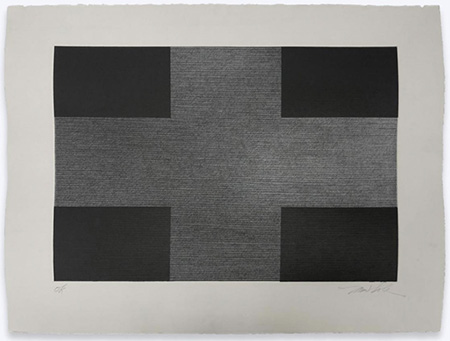
Continuing through October 10, 2021
Max Cole’s latest exhibition of paintings and prints references, excerpts, and overlays the formal concerns associated with different periods of the artist’s career. The show invites us to step inside fifty years of aesthetic inquiry to see how different phases of concern dialogue simultaneously in the present.
The show begins with five framed prints produced from an un-editioned plate Cole etched in the mid-seventies. Each print features fine, repeating diagonal black lines on the original plate which accumulate to create a rectangular field of grey static. But each print has slight variations and addition to that field, laying different time capsules over that ground of static.
Two current works, “Untitled #3” and “Untitled #5,” add a black Greek Cross to the picture plane, as a positive and negative shape respectively. The cross references an artistic origin story. In 1958 Cole was first exposed to the Greek Cross in Russian Supremacist Kazimir Malevich’s painting. That experience catalyzed Cole’s interest in art as a means to explore spiritual and mystical dimensions.
A framed black and white poster circa 1995 shows the artist in her Roswell, New Mexico studio, another temporal focal point. Six large paintings in the show were produced during that residency. From a distance, the large geometric paintings resemble the sliding doors of storage units. They seem at first unyielding, like closed doors. Horizontal lines, delineated primarily by soft variant hues of tan and white, create the illusion of a three-dimensional corrugated surface. It’s set off further by dark lines that could be shadows.
As with the field of static in the first few prints, these works emphasize a perpendicular surface that seems impenetrable from a distance. Stepping up to the paintings, however, the horizontal lines of the picture plane soften into curious, yielding depths. Dark horizontal strips that might be read as shadows are seen instead to be Cole’s characteristically delicate vertical lines. They are thin, belying the human hand, exemplifying a meditative accumulation of effort. Up close, other details come to bear: another repeating horizontal zip of tan is exposed, raw linen, the weave of which is further offset by other horizontal lines of darker tan or white, applied with smooth acrylic paint that lies serenely on the surface of the canvas.
Each abstract work features Cole’s miniscule and repetitive lines that look like solid blocks of gray or black from a distance. Up close, those delicate lines evoke the weave of textiles, marks used to count days, or handwriting that’s been emptied of language. These marks at once measure a finite period of time, labor and focus while stitching together and overlaying formal concerns that vary over the course of decades, concerns that are exemplified by larger blocks of muted color. While the abstract compositions of each work emphasize the perpendicularity of the canvas, the effect of Cole’s multi-temporal intersections expands one’s sense of the present, making us available to the vast simultaneity of then and now.
